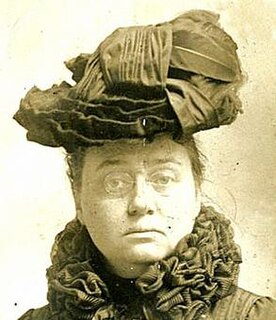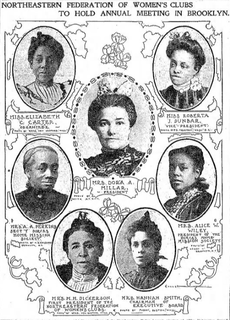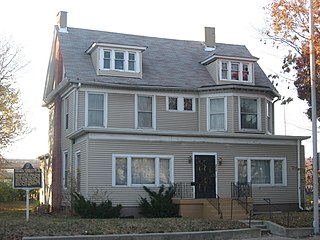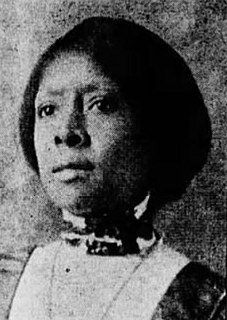
The National Association of Colored Women's Clubs (NACWC) is an American organization that was formed in July 1896 at the First Annual Convention of the National Federation of Afro-American Women in Washington, D.C., United States, by a merger of the National Federation of African-American Women, the Woman's Era Club of Boston, and the Colored Women's League of Washington, DC, at the call of Josephine St. Pierre Ruffin. From 1896 to 1904 it was known as the National Association of Colored Women (NACW). It adopted the motto "Lifting as we climb", to demonstrate to "an ignorant and suspicious world that our aims and interests are identical with those of all good aspiring women." When incorporated in 1904, NACW became known as the National Association of Colored Women's Clubs (NACWC).

Josephine St. Pierre Ruffin was an African-American publisher, journalist, civil rights leader, suffragist, and editor of the Woman's Era, the first national newspaper published by and for African-American women.

Margaret Murray Washington was an American educator who was the principal of Tuskegee Normal and Industrial Institute, which later became Tuskegee University. She was the third wife of Booker T. Washington. She was inducted into the Alabama Women's Hall of Fame in 1972.

Jessie Daniel Ames was a suffragist and civil rights leader from Texas who helped create the anti-lynching movement in the American South. She was one of the first southern white women to speak out and work publicly against lynching of African Americans, murders which white men claimed to commit in an effort to protect women's "virtue." Despite risks to her personal safety, Ames stood up to these men and led organized efforts by white women to protest lynchings. She gained 40,000 signatures of southern women to oppose lynching, helping change attitudes and bring about a decline in these murders in the 1930s and 1940s.

Sarah Visanska was an American clubwoman, president of the South Carolina Federation of Women's Clubs from 1910 to 1912.

The Northeastern Federation of Colored Women's Clubs (NFCWC) is an umbrella organization representing black women's clubs in the northeastern United States. The organization was affiliated with the National Association of Colored Women's Clubs (NACWC). It was the first umbrella organization for black women's clubs in the United States, predating the NACWC by a month. The motto of the club is "For God and Humanity".

Indiana State Federation of Colored Women's Clubs, also known as the Minor House, is a historic National Association of Colored Women's Clubs clubhouse in Indianapolis, Indiana. The two-and-one-half-story "T"-plan building was originally constructed in 1897 as a private dwelling for John and Sarah Minor; however, since 1927 it has served as the headquarters of the Indiana State Federation of Colored Women's Clubs, a nonprofit group of African American women. The Indiana federation was formally organized on April 27, 1904, in Indianapolis and incorporated in 1927. The group's Colonial Revival style frame building sits on a brick foundation and has a gable roof with hipped dormers. It was listed on the National Register of Historic Places in 1987.

The woman's club movement was a social movement that took place throughout the United States that established the idea that women had a moral duty and responsibility to transform public policy. While women's organizations had always been a part of United States history, it was not until the Progressive era that it came to be considered a "movement." The first wave of the club movement during the Progressive era was started by white, middle-class, Protestant women and a second phase by African-American women.
The Texas Association of Women's Clubs (TAWC) is an umbrella organization of African American women's clubs in Texas. It was first organized as the Texas Federation of Colored Women's Clubs in 1905. The purpose of the group was to allow clubs to work together to improve the social and moral life of people in Texas. The club also spoke on topics of interest to black women in the United States.
The Woman's Era Club was an African-American women's civic organization founded in Boston, Massachusetts, in between 1892 and 1894 by Josephine St. Pierre Ruffin. The Club was the first black women's club in Boston. The organization was especially well-known for the conflict caused when Ruffin attempted to desegregate the General Federation of Women's Clubs (GFWC) in 1900.
The Empire State Federation of Women's Clubs (ESFWC) was founded in 1908 and is an umbrella organization for African-American women's groups in New York. The organization worked to help improve the lives of young women and helped care for Harriet Tubman until her death in 1913. The organization was affiliated with the National Association of Colored Women's Clubs, and worked with the NAACP.

The Iowa Federation of Colored Women's Clubs (IFCWC) was an umbrella organization serving African-American women's clubs in Iowa. The motto of IFCWC was "Sowing Seeds of Kindness", and the organization was affiliated with the National Association of Colored Women. The club produced a journal called the Iowa Colored Woman. IFCWC sent delegates to represent the state at national conventions and opportunities such as "Colored Women's day" at the 1939 New York World's Fair. The IFCWC is also known for creating a black women's dormitory for the University of Iowa before the school was fully integrated. The building has been listed on the National Register of Historic Places.

Ora Brown Stokes Perry (1882–1957) was an American educator, probation officer, temperance worker, and clubwoman based in Richmond, Virginia.
Mamie Garvin Fields was a teacher, civil rights and religious activist, and memoirist. In 1909, she became one of the first African-American teachers to be hired in a Charleston County, South Carolina, public school. She was also a co-founder of the Modern Priscilla Club of Charleston in 1927.

Susan Dart Butler was an American librarian and milliner.
Alice W. Wiley Seay was an American social worker and founder of the Empire State Federation of Women's Clubs. She was also involved in charity work through the Dorcas Society and women's clubs. She held leadership roles in many of these organizations.

The Phillis Wheatley Clubs are women's clubs created by African Americans starting in the late 1800s. The first club was founded in Nashville, Tennessee, in 1895. Some clubs are still active. The purpose of Phillis Wheatley Clubs varied from area to area, although most were involved in community and personal improvement. Some clubs helped in desegregation and voting rights efforts. The clubs were named after the poet Phillis Wheatley.
Oregon women achieved the vote in 1912 and throughout the state women in organizations organized around racial groups and ethnicities. Portland had a significant number of African American women’s clubs and organizations, including the Oregon Federation of Colored Women's Clubs.

Maude Brockway was an American teacher, milliner, and activist. She was born in Arkansas in 1876 and moved to Indian Territory after completing her education at Arkansas Baptist College. Initially, she worked as a teacher around Ardmore, Chickasaw Nation and then opened a hat-making business. In 1910, she moved to Oklahoma City and became involved in the Black Clubwomen's Movement. She was one of the founders of the state affiliate, Oklahoma Federation of Colored Women's Clubs and city chapter, Oklahoma City Federation of Colored Women's Clubs of the National Association of Colored Women's Clubs. She served as president of the city chapter from 1925 to 1950 and of the state federation from 1936 to 1940, as well as holding offices in the national organization.












